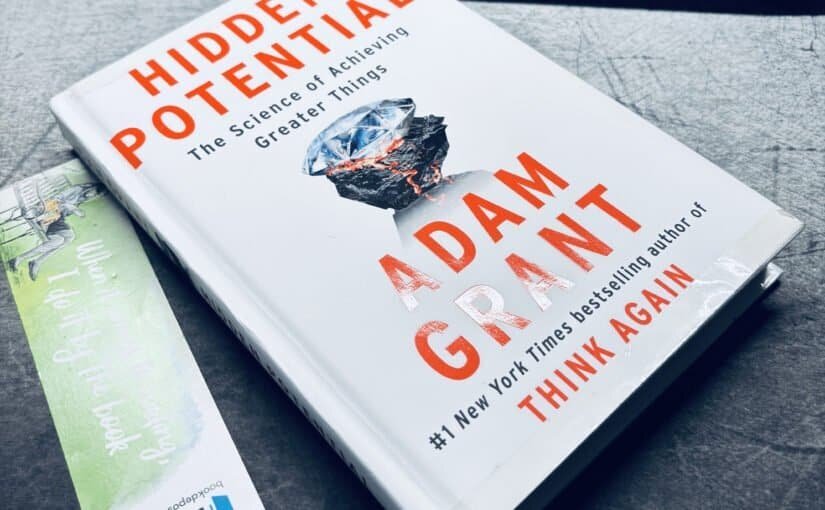Contents
Introduction
In Hidden Potential, Adam Grant challenges traditional views on talent and achievement, arguing that character skills—such as resilience, adaptability, and the courage to embrace discomfort—are just as important as intelligence or natural abilities. Drawing on research from psychology, education, and organizational behavior, Grant illustrates that hidden potential involves more than just personal determination; it also requires creating environments that promote growth. Let’s extend Grant’s ideas with broader perspectives, real-world applications, and related concepts.

If you’d like to purchase the book on Amazon, please follow the links below:
1) Paperback
2) Hardback
Success is About Distance Traveled
One of Grant’s core arguments is that we should judge success not by where someone begins, but by how far they’ve come. This perspective shifts focus from innate intelligence or privilege to perseverance and adaptability. This idea resonates with the Growth Mindset theory by Carol Dweck, which emphasizes that intelligence and ability can be developed with effort. Consider the story of Andrew Carnegie, who emigrated to the U.S. as a poor Scottish boy and later became one of the wealthiest industrialists. His success was not due to privilege but to continuous learning, resilience, and strategic risk-taking.
Embracing Discomfort for Growth
Grant emphasizes the idea that growth happens outside of comfort zones, requiring three types of courage:
- The courage to abandon what’s familiar,
- The courage to apply new knowledge immediately before you feel ready, and
- The courage to make more mistakes than others attempt.
This aligns with Nassim Taleb’s concept of Antifragility, which suggests that systems and people grow stronger through stress and uncertainty. Athletes, for instance, embrace discomfort daily—training harder than necessary to push their limits. A striking example is Michael Jordan, who was cut from his high school basketball team. Instead of giving up, he doubled down on his training, embracing failure and discomfort as part of the process until he became one of the best basketball players ever.
Becoming a Sponge
Grant explains absorptive capacity as the ability to recognize, assimilate, and effectively apply new information. This means not just gathering knowledge but filtering out noise and identifying what truly matters. Charlie Munger also highlights the importance of creating a latticework of knowledge across various disciplines. He suggests that great decision-makers absorb knowledge across diverse fields (engineering, psychology, economics, history) to form a more holistic understanding of the world.
Redefining Perfectionism
Perfectionism, as Grant points out, can be counterproductive. High achievers often obsess over unnecessary details, avoid risks, and fear failure—ironically limiting their potential. Instead, the focus should be on strategic imperfection: knowing which flaws to accept and which to improve. Successful startups like Airbnb and Slack didn’t wait to launch the perfect product; they iterated based on real-world use.
Role of Passion in Practice
Grant discusses harmonious passion, where individuals find joy in the process rather than obsessing over the outcome. This contrasts with obsessive passion, which can lead to burnout. The Japanese concept of Ikigai aligns with this idea. People often discover their purpose where their passions, skills, societal needs, and financial compensation intersect.
Role of Systems in Unlocking Hidden Potential
While personal traits are important, Grant underscores that systems of opportunity—education, mentorship, and workplace culture—play a massive role in who succeeds. For instance, Raj Chetty’s research on economic mobility also shows that a child’s success is significantly shaped by the neighborhood they grow up in. Someone with exceptional potential can be limited by their environment if they lack access to good schools, mentors, or economic stability. This underscores a critical point: unlocking hidden potential isn’t just an individual endeavor—it’s a societal one. If we want to create a world where more people can rise, we need to design better neighborhoods, schools, and policies that support upward mobility.
Conclusion
In conclusion, Adam Grant’s Hidden Potential challenges conventional ideas of success by emphasizing the significance of inner qualities such as character, adaptability, and the courage to embrace discomfort, rather than just talent or achievements. While individual effort and mindset play a crucial role in unlocking potential, Grant also highlights the importance of external systems—mentors, educational opportunities, and supportive environments—that enable growth. By bridging personal resilience with structural opportunities, we can create a society where more individuals have the chance to thrive.
If you’d like to purchase the book on Amazon, please follow the links below:
1) Paperback
2) Hardback
Related Reviews
- Review of Hidden Potential by Adam Grant
- Review of The Diary of a CEO by Steven Bartlett
- Review of How Big Things Get Done by Bent Flyvbjerg and Dan Gardner
- Review of The Formula by Albert-Laszlo Barabasi
Author:
